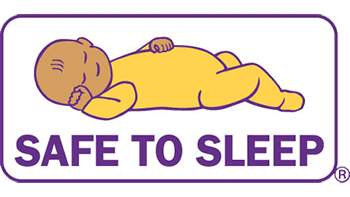 The Safe to Sleep® campaign began in 1994, as the Back to Sleep campaign, then named for its main recommendation for all healthy babies to be placed on their backs to sleep to reduce the risk of Sudden Infant Death Syndrome (SIDS).
The Safe to Sleep® campaign began in 1994, as the Back to Sleep campaign, then named for its main recommendation for all healthy babies to be placed on their backs to sleep to reduce the risk of Sudden Infant Death Syndrome (SIDS).
Led by the Eunice Kennedy Shriver National Institute of Child Health and Human Development (NICHD), part of the National Institutes of Health, and other collaborating organizations, the campaign was expanded and renamed Safe to Sleep® in 2012 to address not only SIDS, but also other sleep-related infant deaths.
Read more about important milestones in Safe to Sleep® history, NICHD’s outreach efforts and partnerships related to the campaign, and the progress of NICHD’s research on safe infant sleep.
2024
Safe to Sleep® continues to add to its resources in multiple languages, with campaign materials, including social media, in Arabic, French, and Spanish.
2023
NICHD launched an updated Safe to Sleep® website with improved organization, streamlined navigation, and a refreshed design. Get a video tour of the updated website
.
2022
During SIDS Awareness Month, Safe to Sleep® introduces the #ClearTheCrib Challenge, a fun activity to raise awareness about safe infant sleep. The Challenge becomes a key part of safe infant sleep activities year-round. Learn more about the #ClearTheCrib Challenge.
2020
NICHD partners with Safe Kids Worldwide
to leverage their nation-wide network of trained community-level organizations and educators. The partnership successfully reaches caregivers in certain communities across the country with safe infant sleep information.
2018
In partnership with campaign collaborators and other organizations, the Safe to Sleep® campaign launches the first #SafeSleepSnap social media activity to bring attention to safe sleep environment imagery during SIDS Awareness Month.
Check out the SIDS Awareness Month Toolkit.
As a part of a partnership initiated in 2015, the Safe to Sleep® campaign and Kappa Alpha Psi Fraternity®, Inc.
, launches a mini-grant program to support fraternity members in conducting safe infant sleep outreach. Through the program, the fraternity hosts activities in their communities, shares safe sleep messages in culturally appropriate ways, and works to educate males—fathers, brothers, uncles, grandfathers, and others—about safe infant sleep.
2016
The Safe to Sleep® campaign revises its messages to reflect the American Academy of Pediatrics 2016 safe infant sleep recommendations.
2015
The Safe to Sleep® campaign partners with the Alabama Department of Public Health on the Alabama Safe Sleep Outreach Project. This multiyear project engages a Safe Infant Sleep Advisory Group, comprising healthcare and service providers with an interest in infant health and care, to conduct outreach activities throughout Alabama related to safe infant sleep. Some of these efforts include community baby showers, tailored outreach materials, and a program focused on first responders.
2014
The Safe to Sleep® campaign marks its 20th anniversary with an article from its director in the Huffington Post.
2013
The Safe to Sleep® campaign begins a multiyear partnership with the Arkansas Infant Mortality Action Group to support community education and outreach related to safe infant sleep. The effort includes a mini-grant program, community events, in-person training at health units and hospitals, and “SIDS Sundays” at community churches and faith-based events.
2012
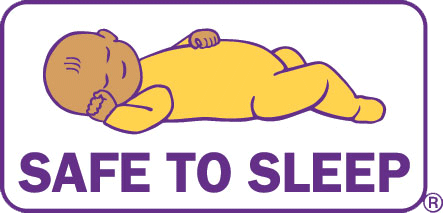
After extensive research and in response to changes in infant mortality data, NICHD and its collaborators launch Safe to Sleep®, an expansion of the Back to Sleep campaign that addresses safe sleep environments, as well as back sleeping, to reduce the risk of SIDS and other sleep-related infant deaths, such as suffocation.
As part of the expanded Safe to Sleep® campaign, NICHD revises materials to incorporate the 2011 American Academy of Pediatrics Task Force on SIDS recommendations as well as the new campaign identity. The campaign reinvigorates collaboration, partnership, and outreach activities related to safe infant sleep.
NICHD debuts an effort initiative to have people across the country to help share safe sleep messages in their communities. Spokespersons, called Safe to Sleep® Champions, leverage their connections to media and community members to raise awareness about the campaign and key messages about SIDS and other sleep-related infant deaths.
2011
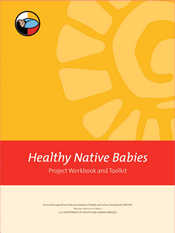
The American Academy of Pediatrics Task Force on SIDS expands its recommendations to address safe sleep environments, which can reduce the risk for all sleep-related infant deaths, including SIDS. These expanded recommendations also include getting regular prenatal care, breastfeeding, and making sure infants receive all recommended vaccinations. The campaign updates its messages and materials accordingly.
The Healthy Native Babies Project Workgroup releases the Healthy Native Babies Project Workbook Packet. The packet includes a workbook that describes the science of SIDS, reducing the risk of SIDS, ways to change SIDS risk factors in American Indian and Alaska Native communities, and a toolkit that allows customization of materials for different Tribes using different Native languages and imagery.
The campaign debuts an online continuing education activity for pharmacists to capitalize on data about the role of pharmacists in their communities. Partners on the effort include the American Association of Colleges of Pharmacy, the American College of Clinical Pharmacy, the American Society of Health System Pharmacists, First Candle, the National Alliance of State Pharmacy Associations, the National Association of Boards of Pharmacy, the National Association of Chain Drug Stores, and the National Community Pharmacists Association.
2009
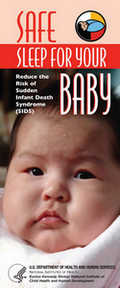
NICHD joins the text4baby™ program, led by the National Healthy Mothers, Healthy Babies Coalition, and the White House Office of Science and Technology Policy. The program delivers evidence-based health information about pregnancy and baby’s first year directly to cell phones and mobile devices. Among the messages in text4baby are the safe sleep recommendations included in Back to Sleep campaign materials.
2006
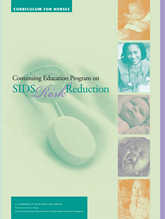
NICHD expands its work in Mississippi to create the Mississippi African American SIDS Outreach Project in collaboration with community- and faith-based organizations across the state. By 2009, the Mississippi Child Death Review Panel Annual Reports for 2007–2010 provide evidence that SIDS deaths have dropped by 35 percent statewide because of the project.
NICHD, the National Institute of Nursing Research, First Candle, and other nursing and national organizations release the first online, accredited continuing education program for nurses about SIDS. The self-study course teaches nurses about SIDS, SIDS risk reduction, and easy ways to model and communicate safe sleep messages to caregivers. Partners in this effort include the Academy of Neonatal Nursing; the American College of Midwives; the Association of SIDS and Infant Mortality Programs; the Association of Women's Health, Obstetric, and Neonatal Nurses; the March of Dimes; the National Alaska Native/American Indian Nurses Association; the National Association of Neonatal Nurses; the National Association of Pediatric Nurses and Nurse Practitioners; the Society of Pediatric Nursing; and the Washington State Department of Health.
NICHD, in collaboration with the SIDS Network of Ohio and the Ohio Department of Health, sponsors a 2-day statewide SIDS summit at the historical Underground Railroad Museum in Flushing, OH. The summit ends with a “SIDS Sunday,” (PDF 1.58 MB) with community leaders using Sunday church services as an opportunity to teach people how to reduce the risk of SIDS.
2005

The Healthy Native Babies Project, led by NICHD and a workgroup of Tribal and other partner organizations, creates culturally appropriate materials and messages for use in five Indian Health Service regions of the Northern Tier of the United States with the highest SIDS rates.
Learn more about the Healthy Native Babies Project.
The American Academy of Pediatrics Task Force on SIDS revises its policy statement about ways to reduce the risk of SIDS. The new recommendations reinforce exclusive use of the back sleep position for every sleep, a firm sleep surface with no loose bedding or blankets, and a separate sleep area for baby. The recommendations also warn against letting baby get too warm during sleep and suggest that using a pacifier can reduce SIDS risk.
2004

The Back to Sleep campaign marks its 10th anniversary by reaffirming its commitment to spreading safe sleep messages in all communities. This recommitment includes running PSAs on radio stations around the country to help educate African American parents, grandparents, and other caregivers about ways to reduce the risk of SIDS and displaying ads on buses in the Washington, DC, area to help spread the message.
NICHD-funded research shows that community education programs in African American communities to teach safe sleep messages have a positive impact and that such efforts are effective for achieving high rates of back sleeping among African American infants.
NICHD and partners launch an initiative to spread safe sleep messages throughout Mississippi, which has some of the highest SIDS and infant mortality rates in the United States.
The collaboration includes the HHS Office of Minority Health, the Health Resources and Services Administration, the Mississippi State Department of Health, the Mississippi SIDS Coalition, the Mississippi SIDS Alliance, the Mississippi Infant Mortality Task Force, Delta Health Partners, the Mississippi Faith-Based Coalition, the Mississippi Head Start Association, and Woman to Woman.
2003

The collaboration between NICHD, the Alpha Kappa Alpha Sorority, Inc., the National Coalition of 100 Black Women, and Women in the NAACP—called the Partnership for Reducing the Risk of SIDS in African American Communities initiative—hosts three regional summits in Tuskegee, AL; Los Angeles, CA; and Detroit, MI, and encourages SIDS risk reduction activities in African American communities.
The Partnership also hosts the first “SIDS Sunday” event to call on faith leaders to help raise awareness about SIDS and ways to reduce the risk of SIDS in their congregations.
2002
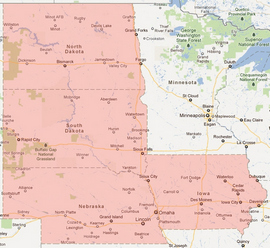
NICHD begins a collaboration with representatives from the Indian Health Service and from national American Indian/Alaska Native (AI/AN) organizations reach AI/AN communities with safe sleep messages. This work builds upon the Aberdeen Area Infant Mortality Study of Northern Plains Indians, which identifies protective and risk factors for SIDS among AI/AI infants.
A collaboration between NICHD, the National Institute of Nursing Research, and nursing and other healthcare organizations results in the first accredited continuing education program on SIDS risk reduction specifically for nurses. This instructor-led activity aims to ensure that nurses know and practice the most current safe sleep recommendations and encourages them to share these messages with parents.
2001
NICHD begins a series of national training workshops on SIDS risk reduction with its partner organizations: Alpha Kappa Alpha Sorority, Inc.; the Women in the National Association for the Advancement of Colored People; and the National Medical Association, the National Coalition of 100 Black Women.
2000
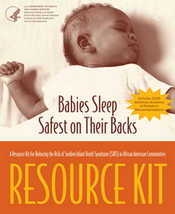
The American Academy of Pediatrics Task Force on SIDS recommendations emphasize that the back position is best, the side position confers risk, and bed sharing may be hazardous under certain conditions. The Back to Sleep campaign revises its messages and materials to reflect this information.
As part of National SIDS Awareness Month, U.S. Surgeon General Dr. David Satcher unveils the campaign’s Babies Sleep Safest on Their Backs: A Resource Kit for Reducing the Risk of SIDS in African American Communitiesand challenges leaders of African American organizations to spread safe sleep messages to reduce the risk of SIDS and infant mortality in African American communities. Campaign messages appear on 50 buses in the metropolitan Washington, DC, area, with support from the D.C. Department of Health.
1999
Johnson & Johnson includes Back to Sleep brochures in its “First Aid Kit for New Parents.” The Pampers Parenting Institute partners with the Back to Sleep campaign, distributing materials to healthcare providers and parents and adding the Back to Sleep logo and message on newborn diapers and packages in English, Spanish, and French.
Read the NICHD news release.
The U.S. Consumer Product Safety Commission, NICHD, and the American Academy of Pediatrics Task Force on SIDS issue a safety alert to remind caregivers that babies should sleep on a firm sleep surface, with no soft bedding in the crib, and with the blanket tucked in “feet to foot” (the baby’s feet are at the bottom of the crib, the blanket is no higher than the baby’s chest, and the blanket is tucked in around the crib mattress, making it unlikely the baby can slip under the blanket).
U.S. Department of Health and Human Services (HHS) Secretary Donna E. Shalala and former second lady Ms. Tipper Gore announce the start of a new component of the Back to Sleep campaign that will focus on reducing the incidence of SIDS among African Americans.
The first meeting, led by NICHD, the National Black Child Development Institute, and the First Candle, about the new component includes representatives from Alpha Kappa Alpha Sorority, Inc., the Women in the National Association for the Advancement of Colored People, the National Medical Association, the National Coalition of 100 Black Women, Chi Eta Phi Sorority, the Chicago Department of Health, the District of Columbia Department of Health, the National Association of Black Owned Broadcasters, the Pampers Parenting Institute, and Zeta Phi Beta Sorority.
1998
The Back to Sleep campaign begins outreach to more than 250,000 childcare centers and licensed childcare homes.
1997
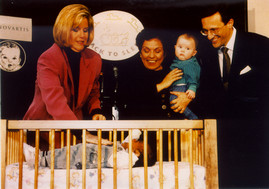
Tipper Gore, wife of then Vice President Al Gore, begins serving as the national spokesperson for the Back to Sleep campaign.
Read the NICHD news release.
Gerber® Baby Products, in partnership with NICHD, includes Back to Sleep messages on rice cereal boxes and mails Back to Sleep messages to mothers. Tipper Gore, wife of then Vice President Al Gore, records a message for the Gerber toll-free information number that plays 7 days a week, 24 hours a day, for a year.
After research shows that African American mothers are less likely to put their babies on their backs to sleep, U.S. Surgeon General David Satcher, M.D., Ph.D., reaches out to communities of color with Back to Sleep messages through news releases and Public Service Announcements.
1996
Based on additional research results, the American Academy of Pediatrics Task Force on SIDS recommends that babies be placed to sleep “wholly on their backs” because the back sleep position is associated with the lowest SIDS risk. The Task Force also recommends using firm sleep surfaces and avoiding the use of soft bedding in cribs.
1994

The U.S. Public Health Service enlists maternal and child health agencies and components to actively participate in the Back to Sleep coalition—a group of organizations that reinforce safe infant sleep recommendations. NICHD mails materials from the newly created Back to Sleep campaign to the membership of the American Academy of Pediatrics and the American College of Obstetricians and Gynecologists; all U.S. hospitals with newborn nurseries; and regional and local clinics of the Special Supplemental Nutrition Program for Women, Infants, and Children. Public service announcements are sent to 6,700 radio stations and 1,000 TV stations to amplify the message that placing infants on their backs to sleep can reduce the risk of SIDS.
NICHD launches the Back to Sleep campaign with several collaborating groups, including the American Academy of Pediatrics; the SIDS Alliance (now First Candle); the Association of SIDS and Infant Mortality Programs; the National Heart, Lung, and Blood Institute; and the Maternal and Child Health Bureau of the Health Resources and Services Administration. The national public education campaign will raise awareness about SIDS and SIDS risk reduction.
U.S. Surgeon General Joycelyn Elders, M.D., issues a policy statement that “healthy infants be placed on their back or side to sleep to reduce the risk of SIDS.”
1993
NICHD funds large-scale studies in Tasmania, Australia, and in England to gather data on the safety of side and back sleeping within the context of SIDS.
1992
Based on research findings, including many from studies supported by NICHD, the AAP Task Force recommends that U.S. babies be placed on their backs or sides to sleep to help reduce the risk of SIDS.
NICHD launches the U.S. National Infant Sleep Position Study. This annual telephone survey assesses related sleep practices of nighttime caregivers in households with infants younger than 8 months of age.
1991
Studies published in Australia, New Zealand, and the United Kingdom show a significant link between SIDS and stomach sleeping. In these countries, emerging public education campaigns recommended that infants be placed to sleep on their sides or backs to reduce the risk for SIDS.
The newly formed AAP Task Force on Infant Sleep Position and SIDS (known as the AAP Task Force on SIDS) begins evaluating NICHD-supported studies and other studies on stomach sleeping as a risk factor for SIDS.
1989
NICHD defines the condition SIDS as “the sudden death of an infant younger than 1 year of age, which remains unexplained after a thorough case investigation, including performance of a complete autopsy, examination of the death scene, and review of the clinical history.”
1988
Medical societies in the Netherlands begin recommending against babies sleeping on their stomachs to help reduce SIDS risk.
1974
Congress passes the Sudden Infant Death Syndrome Act of 1974, recognizing SIDS as a significant public health issue. Congress directs NICHD to take the lead on SIDS research within the U.S. Public Health Service.
1969
Scientists apply the term “Sudden Infant Death Syndrome” to what is now recognized as a distinct condition.

